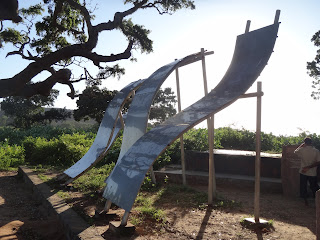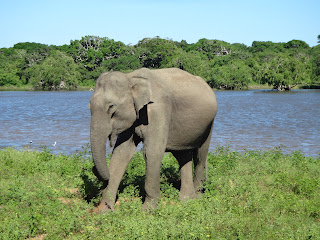Yala is quite a long drive from Galle as it rests on the southeastern coast of the island. There are closer national parks we could have ventured to with a heap of elephants and water buffalo, but Yala is the home of Sri Lanka's 200 leopards and in the off chance we could get to see one, we thought it was worth it.
 |
An albino Green Turtle.
He likes me cause we're both pasty.
|
On our way to Yala, we made a stop at a Turtle Conservation Center and Hatchery. There are 8 different types of sea turtles, 5 of which can be found in Sri Lanka: the green turtle, Olive Ridley, Leatherback, Hawksbill and Loggerhead. All 5 species are listed as critically endangered or endangered. Despite this status, many people are illegally poaching turtle eggs when the turtles come ashore to nest on the beaches. People poach these eggs for human consumption or for sale to 'tourist attraction' hatcheries. The turtle's nesting grounds are also being destroyed by tourist beach development. Some hawksbill turtles are being hunted for the illegal tortoiseshell trade. At this point, for every 1000 turtle eggs laid, only one mature adult turtle is likely to survive. Awful.
 |
Holding a Hawksbill turtle on the mend from a clash with a fishing boat.
His wounds are healing and soon he can return to the sea. |
We made our way to a turtle conservation project along the southern coast to learn more. Here, we saw eggs that were ready to hatch any minute in the sand pit and the tiny baby turtles born in the past few days. The babies are kept for just a few days to get strong and then released back into the wild. The conservation center also had several wounded or sick turtles that were on the mend before they could be released back to the sea. One turtle had his leg cut off in a fishing trap and was here learning how to swim again with his new stump of a leg. The man running this place was very passionate about the turtles and was taking such good care of these little ones. It was great to see all the species of sea turtles in one location to really take in their differences. Very neat.
 |
The sandbox of eggs!
Several species are about to hatch any minute now! |
 |
Hawksbill babies- just a few days old.
Growing big and strong for a few weeks to increase their
chance of survival before being released to the sea. |
We hopped back on the road for a few more hours to reach Yala National Park. We met our guide in the nearby town of Tissamaharama, or Tissa for short. We happened to be on this trip on Poya Day (Full Moon Day), a major event for Buddhists. It's a big weekend of celebration and prayer in the Buddhist community and many families gather together for the day. There were many people taking in the holiday along the river in Tissa- boating and swimming around the lake. When we drove a little farther towards Yala, we saw groups of people bathing in the river- soaping up and rinsing off, changing behind the bushes, and getting ready to head to the temple for prayer. It felt very strange to watch these people bathing out in the open like this, but they don't have any other means of showering or cleaning themselves.
 |
| Bathing in the river. |
 |
The lake in Tissa.
A beautiful Poya Day to spend with nature. |
Anyways, Tissa is where all the safaris take off from so you can see hoards of guides lining the roads trying to pick up tourists. Luckily, our resort staff helped set us up with the most perfect guide/driver. He was aggressive and knew how to track the animals so we could see everything we wanted to see. Any time we'd come up behind another vehicle, our driver would lay on his horn- like beep beep BEEEEEEEEP! He wouldn't let up until the truck in front would heed to let him pass. If they didn't, our driver would just begin to pass them anyways. We always won. Scary but fun. It allowed us to get up in front of the other safari trucks so we got first view of all animals.
Just after entering the gate, we were greeted with grazing water buffalo, wild boar, and land monitors. Land monitors are the largest lizard things I've ever seen! Apparently they don't attack humans, but they too closely resemble kimono dragons for my comfort. Not too long after we saw a large bull. He was grazing and playing in the brush just a few feet from our vehicle. He kept walking closer, seemingly unaware of our gawking stares and photo-snapping. So refreshing to see an elephant in the wild, roaming free of chains and stabbing spears. A beautiful sight.
 |
Water buffalo and his best buddy
locked in a staring contest.
|
We continued down the road to see wild water buffalo and their bird friends. The buffalo and bird have a relationship of mutualism and when you see them together, they just look like ironic friends. Despite the large quantity of water buffalo we saw in Yala, the water buffalo is also an endangered species. Many times we would see the water buffalo hanging around the water holes and mud pits along with the spotted deer and antelope. There was one large rock formation that I joked reminded me of Pride Rock from the Lion King. I later learned it was called Elephant Rock- appropriate since it in fact looks like a side profile of an elephant.
We continued through the park to see all kinds of birds, bats (the largest bats EVER), peacocks, monkey and more! But the one thing I really wanted to see was a leopard. I told our guide to make that happen! He started to lecture me about how all tourists come to Yala and wanted to see a leopard and that there are just 35 leopards in this part of Yala. They're loners so they're spread out over the 3500 acres or something like that and blah blah blah.... I told him that even so I STILL wanted to see one! I gave a big grin so he knew I was being sarcastic (sort of) and he smiled back, turned back to the wheel and started driving around looking for something good to show us. Well, let me tell you, not 10 min later...... wait for it....... WE SAW A LEOPARD!!! It was pretty far back in the trees, sleeping away, but still, we caught a glimpse. And it's probably good to keep your distance from a leopard. That was all I needed to see to make my trip worth it!
 |
Ok, so he's a little far away sitting up in the tree there,
but it's good to keep your distance from a leopard, right? |
 |
| A little zoom action. |
 |
Standing where the Yala Bungalows were standing
before they were destroyed by the 2004 tsunami. |
Our guide took us down to the shore where the Yala Beach Bungalows used to stand. They were completely leveled during the 2004 tsunami along with about 60 tourists and guides (40 of which were Japanese). Interestingly, not many animals were killed during the tsunami because they seemed to sense the impending danger. It has been reported that elephants screamed and ran for higher ground, dogs (domestic and wild) refused to go outdoors, flamingos abandoned their low-lying breeding areas, zoo animals rushed into their shelters and could not be enticed to come back out, and more... Based on those reports, it seems safe to assume that animals really do possess a 6th sense and were able to feel or hear the Earth's vibration and tipping them off to the approaching disaster. Thousands of lives were lost, but few animals succumbed to the tsunami. Fascinating.
 |
A memorial for the 2004 tsunami.
Representing the 3 large waves that took out Yala.
|
We saw so much more than I expected and as the sun started to set, the safari became even more surreal. It was just gorgeous to see the sun setting over the water buffalo and crocodiles and elephants.... words can't even describe how incredible this experience was. Molly has been on a safari in Africa and she kept saying that it so reminded her of her experience there. I'll have to check that one out myself when I make it to Africa. But for now, I'll remember this trip and all it's beauty. Enjoy some more animal pics below!
 |
So close to the animals!
A large bull grazing. |
 |
| Love my monkeys! |
 |
Mama and baby!
Baby was playing with the bird- chasing with her trunk. |
 |
| Eagle |
 |
| Land monitor- doesn't it look like a kimono dragon? |

















No comments:
Post a Comment